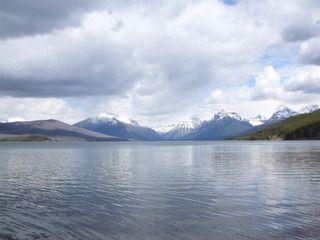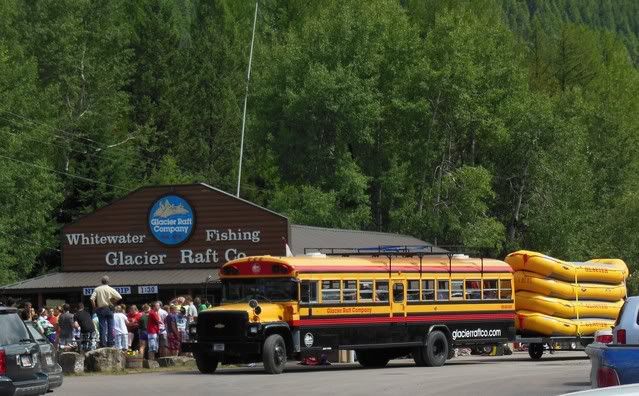( – promoted by navajo)
Glacier National Park was designated our nation’s 10th national park on May 11, 1910. Half of the new park was formed by the “mineral strip” which had been sold by the Blackfoot to the United States in 1895. The enabling legislation for the park, however, contained no reference to the Blackfoot, nor does it acknowledge their hunting, fishing, and timber rights to the area, rights which they had reserved in their treaty with the government. The tribe was not invited to the congressional hearing about the park.

Glacier’s first superintendent was William Richard Logan, the son of an Army captain who made a career out of fighting Indians. He was no friend to Indians, calling them “natural beggars and bummers” and subsequently served as the Indian agent to the Blackfeet and to the Assiniboine and Gros Ventre at the Fort Belknap Reservation. Since he also had little sympathy for conservation, he was made superintendent of Glacier National Park and introduced programs that were developmental rather than environmental.
Glacier National Park, according to archaeological data and Native American oral tradition, has been used by American Indians for more than 10,000 years. When the first Euroamerican explorers began entering the region about two hundred years ago, the Blackfoot controlled the prairies to the east of the Park and used the mountains in the park for hunting, for ceremonies, and for gathering plants. The Salish-speaking tribes (Pend d’Oreille, Kalispel, Flathead) and the Kootenai lived in the valleys to the west.
By the end of the nineteenth century, the policy of the American government was that all Indians were to become farmers with small, family farms. All other forms of economic development were discouraged. Therefore, when there were rumors about the possibility of gold in the mountains on the western portion of the Blackfoot reservation, there was no consideration given to the possibility that the Indians could mine the gold themselves. All of the Americans agreed that the Indians would have to sell the land so that the gold could be exploited by non-Indian mining interests.
In 1895 representatives from the United States government met with 35 handpicked Blackfoot leaders. The United States wanted to purchase the western mountains, but the Blackfoot were reluctant to sell. Under much pressure, the handpicked leaders agreed to the sale and asked for $3 million, but the government paid them only $1.5 million.
The mountainous area involved in the sale was an area in which the Blackfoot traditionally hunted, fished, gathered plants, cut timber, and conducted religious ceremonies. Indian religions were illegal at this time so the Blackfoot were quiet about the spiritual use of the mountains. However, since the government seemed concerned about minerals, the Blackfoot insisted that they must maintain all non-mineral rights to the area. White Calf told the Americans:
“I would like to have the right to hunt game and fish in the mountains. We will sell you the mountain lands from Birch Creek to the boundary, reserving the timber and grazing land.”
One of the American negotiators was George Bird Grinnell who felt that there would be few minerals found in the area. Grinnell, however, felt that it was important to destroy Indian cultures by breaking up the communal ownership of land. Grinnell also felt that the area had great scenic potential and could be a tourist destination.
Indians and Hunting:
Two years after the creation of Glacier National Park, two Blackfoot hunters were arrested for hunting in their usual areas within the park. Their firearms, traps, and hides were taken from them. The Department of the Interior later instructed the park to return these items, but the Indians were not to be allowed in the park.
At this time, non-Indians were allowed to hunt in the park and government hunters were actively seeking to exterminate coyotes, wolves, and mountain lions within the park. While the Blackfoot felt that the treaty had reserved their right to hunt in the park, the government simply ignored their concerns.
In 1924, Peter Oscar Little Chief began to circulate a petition among the Blackfoot calling for a recognition of their hunting rights in Glacier National Park. He claimed that the Blackfoot retained these rights in their 1895 treaty:
“We sold to the U.S. Government nothing but rocks only. We still control timber, grass, water, and all big or small game or all the animals living in this [sic] mountains”
He submitted his petition to the Bureau of Indian affairs, but received no response.
In 1929, Peter Oscar Little Chief complained to Senator James Walsh that the Bureau of Indian Affairs had not responded to his 1924 petition regarding Blackfoot hunting rights in Glacier National Park. Walsh contacted the Commissioner of Indian Affairs who knew nothing about the petition but informed Walsh that Indians had no hunting rights in the park.
In 1929, assuming that the Blackfoot were subject to state law, the National Park Service attempted to end hunting near the eastern border of the park. Wardens arrested Blackfoot and Cree hunters for killing elk east of the park boundary. The judge, however, released the men and returned the elk to them. State officials were angered by the judge’s decision and demanded further prosecution. The National Park Service then advised the Indian agent in Browning, the capital of the Blackfoot Nation, that the elk in Glacier National Park were not native, but had been imported from Yellowstone National Park and therefore the Indians did not have the right to hunt them. The Indians simply laughed at this tale.
In 1955, the deer and elk herds in Glacier National Park increased beyond the park’s capacity. Rangers killed many animals and drove others onto the adjacent Blackfoot reservation. Blackfoot hunters, however, were not allowed to hunt the animals within the park.
In 1991, Blackfoot tribal chairman Earl Old Person, commenting on Indian rights to hunt, fish, gather, and cut timber in Glacier National Park, said: “We only sold them the rocks.”
In 2000, two Blackfoot tribal members killed two bighorn sheep in Glacier National Park. When the two were charged with violating a federal wildlife protection statute, they argued that the Blackfoot have treaty hunting rights to the area. They pointed out that in the1896 agreement with the United States, the tribe retained its right to hunt, fish, and harvest timber in the area. The federal judge did not agree and one of the two men was found guilty of violating the Lacey Act which prohibits the sale of wildlife parts when the animals are killed illegally.
Indians and Tourists:
Glacier National Park was created in part because of the commercial interests of the Great Northern Railway. The park provided a tourist destination and the Great Northern provided the transportation and also owned the concessions within the park. Great Northern promoted the park as an “Indian” destination and referred to the Blackfoot as “Glacier Park Indians.” Tourists were met by Indians as they got off the train and there were tipis around the park lodges.
As a part of its Glacier National Park promotion, the Great Northern Railway in 1915 produced a movie entitled A Day in the Life of a Glacier Park Indian. In addition, the Great Northern Railway took six Blackfoot to the San Francisco Exhibition where they presented lectures, movies, and transparencies about Glacier National Park.
In 1928, the Great Northern Railway published American Indian Portraits which featured paintings of Blackfoot Indians.
Indian Rights:
The Blackfoot and the Kootenai had explored and used what is now Glacier National Park for thousands of years and during this time they had given names to all of the major geographic features of the area. The United States government, however, ignored the aboriginal names and proceeded to rename these features. Thus the mountain known as Napi (Old Man or Trickster) to the Blackfoot was named Mount Cleveland in 1898 as a way of honoring President Grover Cleveland. The glacier known as Azina Kokutoi (Gros Ventre Ice) to the Blackfoot was named Dixon Glacier in honor of Senator Joseph M. Dixon, who had helped push through the legislation which established Glacier National Park. Dixon also pushed through a bill which broke up the Flathead Reservation and added greatly to his personal wealth. The list of geographic features named for presidents, wealthy men, politicians, and their friends is fairly long.
In 1915, Blackfoot leaders Curly Bear, Wolf Plume, and Tail Feathers Coming Over The Hill visited Washington, D.C. to complain about the renaming of mountains, lakes, rivers, and glaciers in Glacier National Park. The Indians wanted Blackfoot names used and they were promised that in the future only Indian names or their translations would be used.
In 1925, as a part of a publicity program for the Park, author J.W. Schultz, known for his autobiographical novel My Life as an Indian, began a program of assigning Blackfoot names to the Park’s features. Working with Eli Guardipee, Curly Bear, and other Blackfoot elders, the plan was to begin at the southeastern corner of the Park and work northward along the eastern slope of the Rocky Mountains. The idea was to assign names of Indians painted by George Catlin and Charles Bodmer rather than reasserting the aboriginal names.
In 1929, the National Park Service proposed to enlarge Glacier National Park by adding more Blackfoot land to the park. Ignoring the Blackfoot, the National Park Service asked the Bureau of Indian Affairs for help in the matter and enlisted the aid of an “Indian expert”. The park was told that the Blackfoot would not give up an additional area to the park for any money consideration.
In 1973, Blackfoot tribal member Woodrow L. Kipp refused to pay the entrance fee to Glacier National Park and was cited. In federal court Kipp was acquitted because of the 1895 agreement which allows the tribe free access to public lands taken from the tribe.
In 1975, the Blackfoot with the aid of the Native American Rights Fund petitioned the Secretary of the Interior claiming that the tribe has retained rights in the ceded “mineral strip” area which became Glacier National Park. Environmentalists condemned the Blackfoot:
“Indians may destroy something of value to both themselves and the rest of the nation.”
The Department of the Interior rejected the petition.
In 1973, Blackfoot tribal member Darrell R. Momberg was arrested for tree cutting inside Glacier National Park. While the 1895 agreement does allow timber harvest, Momberg was convicted because he had not cut the wood for personal use as specified in the agreement.

Leave a Reply